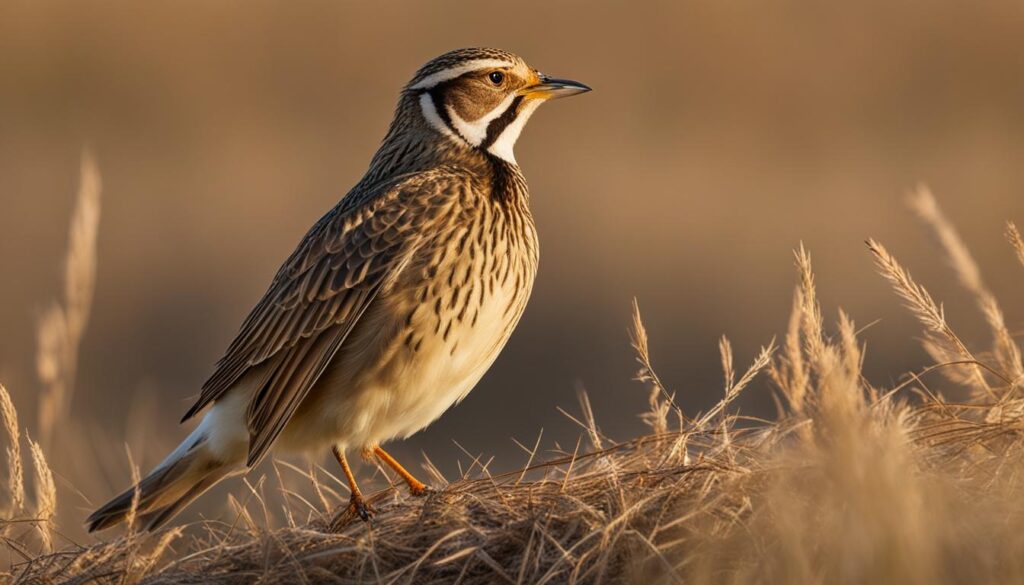Sparrows and larks are both types of birds that share similarities but also have distinct differences. Understanding these differences can help bird enthusiasts and researchers appreciate the unique qualities of each bird.
Key Takeaways:
- Sparrows and larks have different behaviors, habitats, and appearances.
- Sparrows are small birds with a striking head pattern, while larks are larger birds with a long, rounded tail.
- Sparrows are found in prairie, grassland, and agricultural areas, while larks inhabit desert scrub and other open areas.
- Male sparrows sing from elevated perches to attract females, while male larks display on the ground.
- Sparrows and larks have different preferred habitats and distributions across North America.
Sparrow Characteristics
Sparrows are small birds known for their distinctive characteristics and striking head patterns. These birds have a thick bill and a range of colors and patterns on their head, including dark, light, and reddish stripes. Adult sparrows have a striking head pattern with a chestnut crown and cheek patch, a pale stripe over the eye, and a strong black malar or mustache stripe. They also have black streaks on their back, adding to their unique appearance. Juvenile sparrows, on the other hand, have a brown-on-white head pattern and streaks on the breast. Immature sparrows resemble adults in their face pattern but lack the chestnut coloration.
There are various species of sparrows, each with its own distinguishing features. Some species have a colorful head pattern, while others have different arrangements of stripes and colors. Despite these variations, sparrows are generally small birds with a bold, complex head pattern that sets them apart from other avian species.
“Sparrows are small birds known for their distinctive characteristics and striking head patterns.”
Sparrow Species and Characteristics
| Sparrow Species | Distinctive Characteristics |
|---|---|
| House Sparrow | Gray crown, black bib, and brown back |
| Song Sparrow | Brown streaks on the breast and a streaked crown |
| White-throated Sparrow | White throat patch and yellow lores |
| Chipping Sparrow | Rufous cap and clean, unstreaked breast |
Sparrows are also known for their distinctive call notes. They produce a thin chip call, which is their characteristic vocalization. This call note can help bird enthusiasts and researchers identify sparrows in the field.
In summary, sparrows have various species with distinguishing features that include a striking head pattern, black streaks on their back, and unique arrangements of colors and stripes. These small birds are known for their bold appearance and distinctive vocalizations, making them a fascinating group of avian species to study and observe.
Lark Characteristics
Larks are a fascinating group of birds known for their distinctive features and behaviors. Here, we dive into the distinguishing characteristics of larks and explore the various species that make up this avian family.
One of the key features that sets larks apart is their size. Unlike sparrows, larks are larger birds, with an impressive presence. Their long, rounded tail is a defining characteristic, often accompanied by white corners that flash in flight, adding a touch of elegance to their appearance. Additionally, larks have a chestnut crown and cheek, pale eyebrows, and a dark mustache stripe, which give them a unique and eye-catching head pattern.
Like sparrows, larks also display a range of colors and patterns on their head, including dark, light, and reddish stripes. This intricate plumage adds to their overall beauty and makes them a delight to observe in their natural habitats. Juvenile larks have a distinct brown-on-white head pattern and streaks on the breast, while immature larks bear a resemblance to adults but lack the chestnut coloration.

In addition to their physical characteristics, larks are known for their unique call notes. They produce a thin chip sound that sets them apart from other bird species, adding to their charm and mystique. With their striking appearance and captivating vocalizations, larks are truly a remarkable part of the avian kingdom.
Behaviors and Habits
Sparrows and larks exhibit different behaviors and habits, setting them apart from each other. Sparrows primarily feed on the ground, foraging for seeds and insects. They are known to hop along the ground in search of food, using their strong beaks to crack open seeds and capture small insects. Larks, on the other hand, also feed on the ground but have the ability to fly into trees and shrubs when disturbed.
During the breeding season, male sparrows and larks display distinct behaviors to attract females. Male sparrows are known for their elevated perch singing, where they sing melodic and repetitive songs to establish territories and attract mates. The songs are often used to communicate with other sparrows as well. In contrast, male larks engage in ground displays to attract females. They strut back and forth on the ground, with their tails spread and wings drooped, showcasing their agility and prowess.
Additionally, sparrows and larks may differ in their territorial behaviors. Sparrows are generally more territorial and will defend their nesting sites and feeding areas from intruders. They display aggressive behaviors, such as chasing away other sparrows or engaging in vocal disputes. Larks, on the other hand, may have less territorial tendencies, although they may still defend their immediate nesting areas if necessary.
Vocalizations of Sparrows and Larks
“Chip!” A familiar sound that birdwatchers often associate with sparrows. Sparrows are known for their thin chip call note, which they use for various purposes, including communication, warning signals, and to establish their presence. The chip note is short and distinct, making it easy to identify when walking through grasslands or open areas.
Larks also have their own vocalizations, but their calls are different from those of sparrows. While sparrows have a chip note, larks have a more melodic and complex song. Their songs are often described as a series of ascending and descending notes, with variations in pitch and rhythm. These songs are used for communication, territorial defense, and courtship displays.
Summary
Overall, sparrows and larks demonstrate unique behaviors and habits that differentiate them from each other. Sparrows are ground-foragers with territorial tendencies, known for their thin chip call notes. On the other hand, larks are larger birds capable of both ground and aerial movements, using their melodic songs and ground displays to communicate and attract mates. Understanding these behavioral differences adds to the fascination and appreciation of these avian species.
Habitats and Distribution
Sparrows and larks have distinct preferred habitats and distributions. Understanding their habitat preferences is essential for identifying and observing these bird species in the wild.
Sparrow Species and Habitat
There are several species of sparrows, each with its own unique habitat preferences. Common sparrows, such as the House Sparrow (Passer domesticus), are adaptable and can be found in a variety of habitats, including urban areas, grasslands, and agricultural fields. Song Sparrows (Melospiza melodia) are commonly found in shrubs and thickets near water sources, while Chipping Sparrows (Spizella passerina) prefer open woodlands and forest edges.
Other sparrow species, such as the Savannah Sparrow (Passerculus sandwichensis), are commonly found in grasslands, salt marshes, and coastal dunes. The Field Sparrow (Spizella pusilla) prefers open fields with scattered shrubs and trees, while the Lark Sparrow (Chondestes grammacus) can be found in grasslands, prairies, and desert scrub.
Lark Species and Habitat
Similar to sparrows, larks also have specific habitat preferences. Meadowlarks, such as the Western Meadowlark (Sturnella neglecta) and Eastern Meadowlark (Sturnella magna), are commonly found in grasslands, pastures, and agricultural fields. They prefer open areas with short grasses and scattered shrubs.
Horned Larks (Eremophila alpestris) can be found in open country habitats, including grasslands, deserts, and tundra. They are commonly seen on the ground, foraging for seeds and insects.
Differences in Distribution
The distribution of sparrow and lark species varies across North America. Some species, such as the House Sparrow, have expanded their range and can be found throughout the continent. Others, like the Sagebrush Sparrow (Artemisiospiza nevadensis), have a more limited distribution and are restricted to sagebrush habitats in the Western United States.
Larks, on the other hand, have a more widespread distribution, with species like the Horned Lark found across North America. Western Meadowlarks are commonly found in the western half of the continent, while Eastern Meadowlarks are found primarily in the eastern United States and southern Canada.
Table: Habitat and Distribution of Sparrows and Larks
| Sparrow Species | Habitat | Distribution |
|---|---|---|
| House Sparrow | Urban areas, grasslands, agricultural fields | Throughout North America |
| Song Sparrow | Shrubs, thickets near water sources | North America, including parts of Mexico and Central America |
| Chipping Sparrow | Open woodlands, forest edges | North America, including parts of Mexico and Central America |
| Savannah Sparrow | Grasslands, salt marshes, coastal dunes | North America, including parts of Mexico and Central America |
| Field Sparrow | Open fields with scattered shrubs and trees | Eastern and Central United States, parts of Canada |
| Lark Sparrow | Grasslands, prairies, desert scrub | Western United States, Mexico |
| Lark Species | Habitat | Distribution |
| Western Meadowlark | Grasslands, pastures, agricultural fields | Western half of North America |
| Eastern Meadowlark | Grasslands, pastures, agricultural fields | Eastern United States, southern Canada |
| Horned Lark | Grasslands, deserts, tundra | North America, including parts of Mexico |

Conclusion
In conclusion, the difference between sparrows and larks is evident in their characteristics, behaviors, habitats, and distributions. Sparrows are small birds with a distinctive head pattern, while larks are larger with a unique tail shape. These differences make it easy to distinguish between the two species.
When it comes to behaviors, sparrows primarily feed on the ground for seeds and insects, while larks also feed on the ground but can fly into trees and shrubs. During the breeding season, male sparrows sing from perches to attract females, while male larks display on the ground with their tails spread and wings drooped.
Additionally, sparrows and larks have different habitat preferences. Sparrows can be found in prairie, grassland, and agricultural areas, as well as desert scrub and sagebrush habitats. Larks, on the other hand, inhabit desert scrub, sagebrush, grasslands, farmlands, and open country with scattered trees and shrubs.
By understanding these differences, bird enthusiasts and researchers can appreciate the unique qualities and features of sparrows and larks. Whether it’s the striking head pattern of sparrows or the beautiful tail shape of larks, each species brings its own charm to the avian world.
FAQ
What are the differences between sparrows and larks?
Sparrows and larks differ in their behaviors, habitats, and appearances. Sparrows are small birds with a bold, complex head pattern and are found in prairie, grassland, and agricultural areas. Larks are larger birds with a long, rounded tail and are found in desert scrub, sagebrush, and open areas.
What are the distinguishing characteristics of sparrows?
Sparrows are small birds with a thick bill and a striking head pattern. They have a chestnut crown and cheek patch, a pale stripe over the eye, and a strong black malar or mustache stripe. Sparrows also have black streaks on their back and come in a range of colors and patterns.
What are the distinguishing characteristics of larks?
Larks are larger birds compared to sparrows with a long, rounded tail that has white corners visible in flight. They have a chestnut crown and cheek with a pale eyebrow and a dark mustache stripe. Larks also have bold head patterns with dark, light, and reddish stripes.
How do sparrows and larks behave differently?
Sparrows are known to feed on the ground for seeds and insects, while larks also feed on the ground but can fly into trees and shrubs when disturbed. During the breeding season, male sparrows sing from elevated perches to attract females, while male larks display on the ground, strutting back and forth with their tails spread and wings drooped.
Where can sparrows and larks be found?
Sparrows are commonly found in prairie, grassland, agricultural areas, and other open areas. They can also be found in desert scrub and sagebrush habitats. Larks inhabit desert scrub, sagebrush, and other open areas. They are typically found in grasslands, roadsides, farmlands, pastures, and open country with scattered trees and shrubs.



